Forchheim is an old royal town in Upper Franconia and is considered the gateway to Franconian Switzerland. Not only the city, but also the surrounding area invites you to explore.
The sights of Forchheim are located in the historic city center and can be easily explored during a walk. In the evening, don’t miss visiting the Forchheim cellars (Forchheimer Keller) and reviewing the day over a beer.
Fortress of Forchheim
In 1552, Kulmbach troops occupied Forchheim for three months. After the recapture of the city, the High Diocese of Bamberg decided that the city would have to be better protected in the future. It was decided to build a border fortress based on the Italian model.
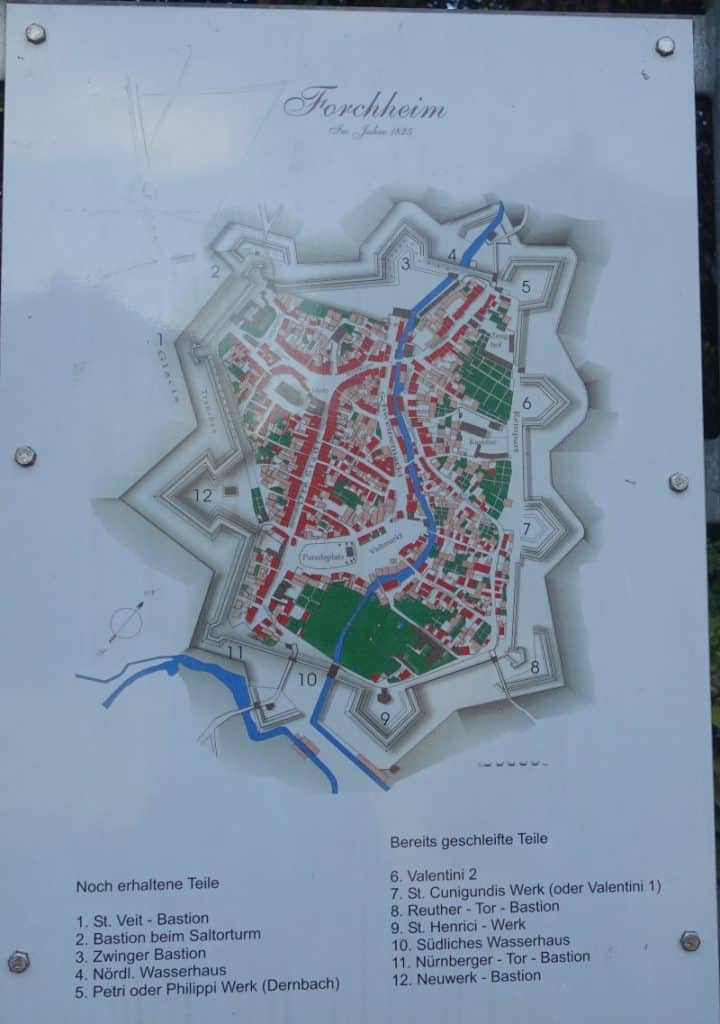
In 1553, the construction of the St. Vitus bastion began south of the Forchheim Palatinate (castle). In the following years the fortress construction was extended by the bastion near the Saltor Tower and the entrance gates : Bamberg Gate, Reuther Gate, Nuremberg Gate, Sattler Gate were built. Two surge tanks secured the inflow and outflow of the Wiesent river.
The fortification had its first test during the Thirty Years’ War. The medieval city walls and the new buildings were apparently enough deterrent, the city was hardly besieged. After the end of the fighting, the construction of the fortress continued. 10 bastions were built, connected by long curtain walls. In front of them was a moat about 30 meters wide. In addition, numerous administrative and representative buildings were built inside the fortress.

After the fortifications were no longer used by the army in 1838, the city finally bought them back. It undertook to demolish the complex. After the First World War, a large part of the fortress disappeared from Forchheim. The material was used, for example, for the construction of the municipal high school. Some of the trenches were transformed into parks, which are still used by the population today.
Which buildings of the fortification are still present in the cityscape today?
When searching for traces of the “remains” of the fortifications, you will quickly find them in Forchheim. During a walk through the city, for example, you will find the medieval city wall near Sattlertorstraße. Two bastions in the northwest of the old town are still preserved from the first stage of expansion based on the Italian model.

In front of the St. Vitus Bastion you can walk wonderfully today. By chance, I also discovered a coat of arms that can be seen on the wall. The courtyard between the bastions is still almost completely preserved. Only at the district court it is missing and one has a beautiful view of the building.
In the St. Vitus Bastion today there is the Red Wall-Veit Bastion Adventure Museum. It is worth to pass by here. Numerous panels inform about the fortress construction and defense system.

In the small museum, the everyday life of a besieged city is presented in stagings, texts and radio plays. However, I was much more impressed by the large interior of the bastion, the casemate, with its small loopholes. The idea of how the soldiers sat together here for the city’s defense is quite exciting. What a background noise, a smell must have been….

The Saltor Tower is the last remnant of the medieval city fortifications. From there, the route continues to the “newer” city fortifications of Forchheim. The connection to the medieval fortification is interrupted by a road.
The St. Valentini work (Zwinger bastion) and the courtyard running towards it from 1657 are completely preserved. The bastion is triangular and invites to a walk. During a guided tour it is also possible to enter the bastion through the escarpment passage.

One city gate, the Nuremberg Gate, is still preserved. The representative Prunktor stands today rather hidden and has no direct connection to the former fortification of the city. I find the coat of arms, which is held by two lions, particularly beautiful.

Visit to the Imperial Palace – the castle in Forchheim
In the late 14th century, the castle in Forchheim was built, which was one of the most important city castles of the Bamberg bishop.

Via a sandstone bridge, the visitor enters an approximately square enclosure. In the past, the moat could be crossed via a drawbridge, which could be raised in case of an attack.

Large parts of the main building and the courtyard building date back to the 14th century. In the middle of the 16th century the castle was rebuilt. Half-timbered corridors were built above the connecting walls. Later, an octagonal stair tower with a stone staircase was placed in front of the main building.
Today, the castle houses the Palatinate Museum in the east wing with three sections: Upper Franconia Archaeology Museum, Forchheim City Museum and the Museum of Traditional Costumes of Franconian Switzerland. The west wing is an administrative wing.

Museum visit
I was able to take a brief look at the east wing of the Imperial Palace and was thrilled.
On the first floor there are two large halls that are used for special exhibitions. Since renovations were underway here, I had an unobstructed view of the size of the rooms and the remarkable ceiling supported by sandstone pillars. Fragments of a beautiful painting are still preserved on the walls. This was applied to the dry plaster around 1400 and is amazingly well preserved.
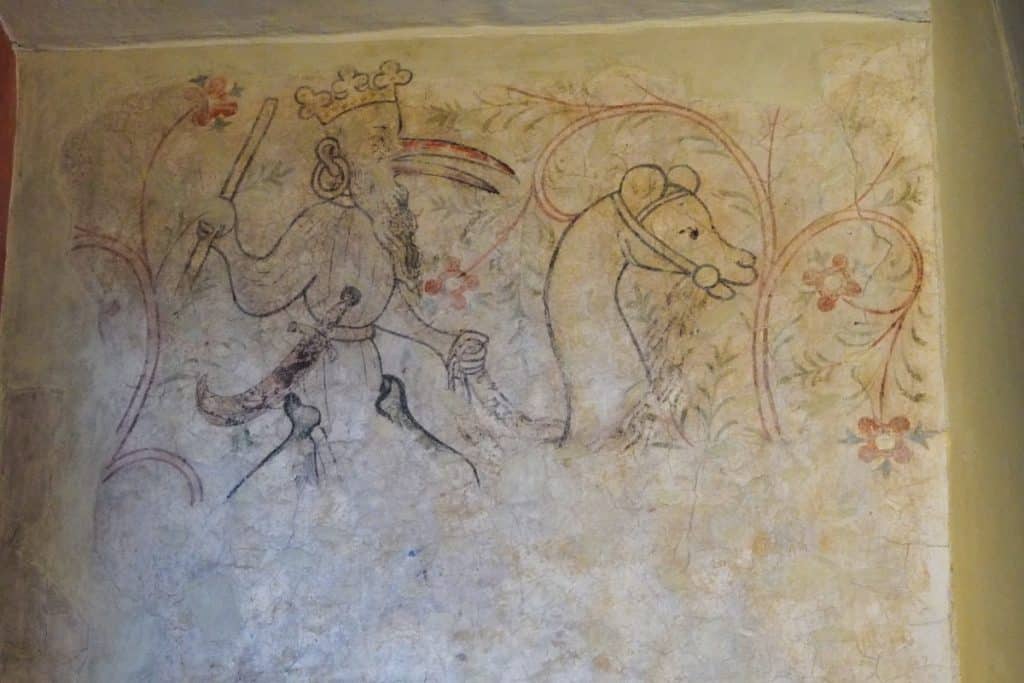

An elevator, for which a modern extension to the historic building was built, takes you to the upper floors, where the special museums are located.
The Archaeological Museum of Upper Franconia exhibits finds from the Stone Age to the early modern period. From jewelry to historical weapons, the visitor can get information about life in Franconia.

The Trachten Museum shows the variety of traditional costumes that were worn in this region and are still worn today on special occasions. Even though I like some of the colorful dresses, I still don’t want to wear them. They seem heavy and uncomfortable.
I especially liked the visit to the city museum. The history of Forchheim is presented here in multimedia form and I felt transported back to the “good old days” at some of the exhibits. Exciting – the classic film “City Without Pity” was made in Forchheim in 1961, which some exhibits and film scenes remind us of.
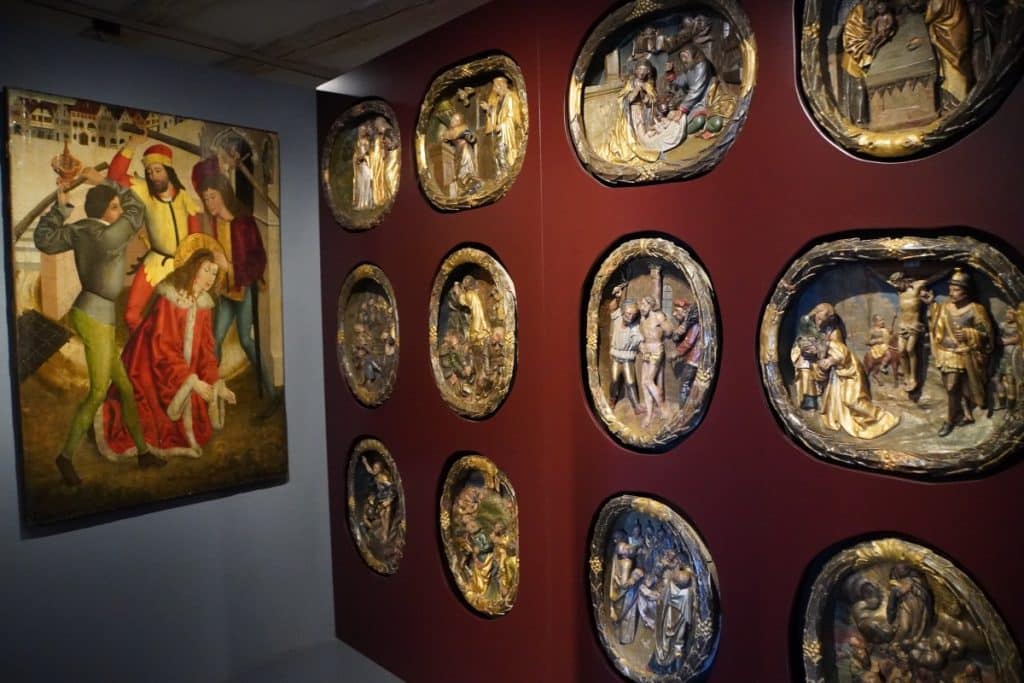
When visiting the three museums, however, one should not only take a look at the exhibits, but also consciously perceive the rooms. Everywhere on the walls you can discover old wall drawings that tell something about the history and culture of the city. The pictures, the techniques reveal, are by different artists.
Even though the visit was short, I was able to get a good impression of the museums. I liked them and was able to take away one or two pieces of information about Forchheim.
Sights in the old town
In addition to the fortress and the imperial palace, we were able to discover one or two places not to be missed while walking through Forchheim’s old town.

One thing immediately catches the eye, in Forchheim there are many beautiful half-timbered houses, which are still excellently preserved.
Porta Vorchheimensis
In the pedestrian zone stands a door that the Rotary Club has donated to the city. It is an impressive work that you should definitely take a closer look at. On the opened door leaves there are beautiful relief works. These represent the history of Forchheim. I find the work very successful and when looking at the pictures I notice every time new details.


Konradbrunnen
Conrad I holds the imperial orb in his left hand The fountain in the immediate vicinity of the parish church of St. Martin was erected in memory of the Franconian Duke Conrad I, who was proclaimed East Franconian King (911 in Forchheim).

Local court
Right next to the Palatinate stands a building in the neo-Renaissance style. It was built in 1896 directly on the city wall and is now the building of the district court.

Salt Magazine
The large stone building with its three floors and high roof served as a salt store until the middle of the 19th century. Today, the building is used as a residence.

Kammerers Mill
What a beautiful half-timbered building, located on the Wiesent River. Kammerer’s mill was already built in the Baroque period. Over the years, the building tilted further and further towards the river and thus received the name “Leaning House”.

Synagogue monument
The synagogue memorial commemorates the synagogue in Forchheim, which was desecrated and devastated during the Reichskristallnacht. Only one day later, the building was blown up.

Fish boxes in Little Venice
The Wiesent flows almost picturesquely through Forchheim. It almost seems as if one is traveling along the canals of Venice. Here in the Little Venice of Forchheim, wooden sheds simply stand on the banks.

These are not boathouses, but fish boxes, which are still in use today. This is where the fishmongers from Forchheim water the carp from the ponds in the region until they finally sell them.

Forchheim churches
During a short tour of the city we passed beautiful churches and chapels, some of which surprised us inside.
Parish Church of St. Martin
The parish church in the middle of the old town of Forchheim with its towering spire is an ideal landmark in the city. The doors were open and so we were able to take a look inside the church.
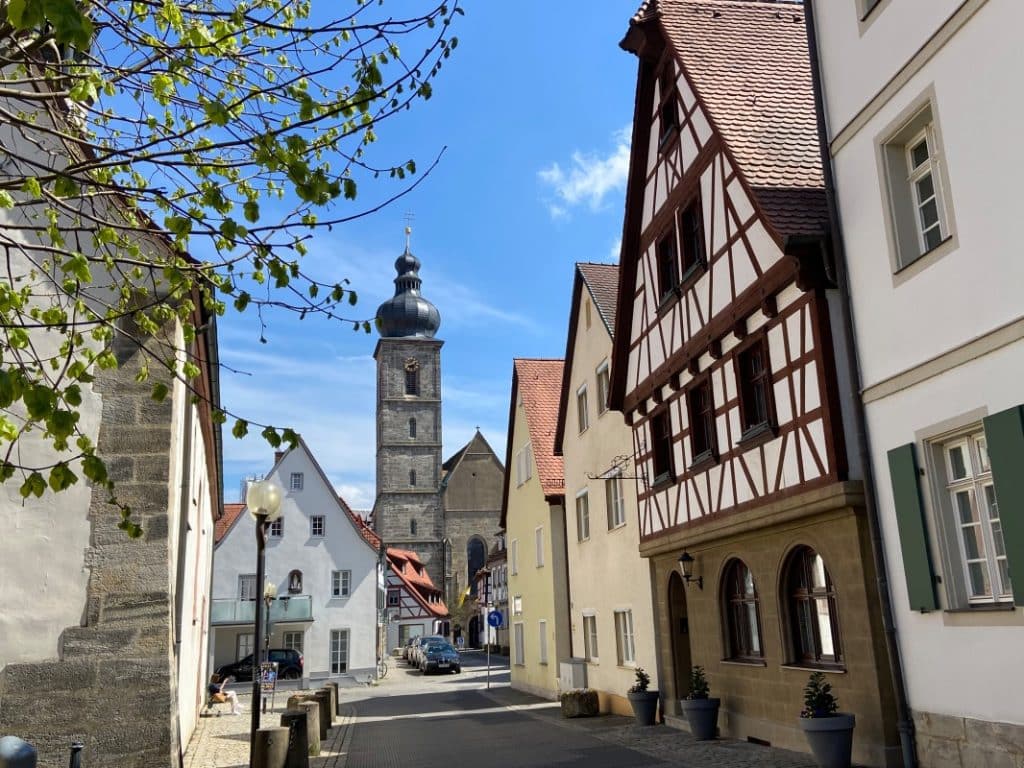
The church is an old royal church, which Otto II gave to his cousin Bishop Poppo II of Würzburg.1017 Bishop Eberhard of Bamberg exchanged again the parish church, which from then on was connected with the High Diocese of Bamberg. Around 1200, the building was replaced by a late Gothic church.
Of this church, the transept and the crypt below are still preserved today. The crypt can be reached via a staircase in the church. There is a smaller altar here and some pews invite to pray.
In 1354 the church was transformed into a collegiate monastery for secular clergy, structural changes transformed the place of worship into a high Gothic basilica. Only with the secularization in 1803 the church became an ordinary parish church.

View into the church
As we enter the church, we stand before an impressive baroque high altar. This dates from 1698, and the beautifully designed figures were made by a Bamberg court sculptor. The oversized figures represent the Bamberg bishopric patrons Heinrich II and his wife Kunigunde.

Next to the altar I discover a beautiful carving depicting St. Martin, the patron saint of the church. It impressively shows the division of the mantle. It is a pity that it has found a “place in a corner” in the church and thus hardly catches the eye.

A magnificent pulpit hangs from a column facing the central nave. Figures of angels decorate the roof. Between the columns of the nave hang panel paintings that belonged to the previous altar. This was from the 15th century. It is worth to have a closer look at the paintings. I particularly liked the scenes from the life of St. Martin.
Before I leave the church, I notice a pilgrim’s stamp. Here pilgrims on the Way of St. James have the opportunity to document their station on the way.

Hospital Church of St.Catherine
The hospital church is located directly on a small bridge over a canal. It was built around 1490 in Gothic style. Unfortunately, I could not look into the church. It is supposed to be the baroque-rococo style inside.
The Spitalkirche belonged to a hospital that probably originated in the 12th century. I find it very exciting that a nativity scene has been set up there at Christmas time for over 200 years. This has movable figures and six changing representations.

Church St.Johannis
The population in Forchheim is predominantly Catholic. In the middle of the 19th century, a young Protestant congregation emerged, to which about 150 people belonged around 1861. They held their services in the Gereonskapelle, which they were allowed to use free of charge. In the course of the beginning industrialization many people moved to the city. The number of Protestants increased tenfold in a very short time and so it was decided to build a new church.

An architect from Bamberg designed a church building. However, at the request of the church administration, he had to deviate from his original ideas and work with very limited financial resources, among other things. This resulted, for example, in the church looking very plain from the outside.
In 1895, the topping-out ceremony was celebrated and already in 1896 the church building was finished and consecrated. The church was named after the apostle John, whose name stands especially for brotherly love among Christians.
I find it particularly interesting that the main interior furnishings of the church at that time were gathered almost exclusively through donations. In the following years, the congregation then expanded the furnishings to include, for example, electric lights, painted windows and a sound cover for the pulpit.

During the Second World War, the damage caused to the Forchheim church was quite minor, mainly windows were broken. In the following years, the church building was gradually modernized and renovated. In the process, the character of the church interior changed completely. It was not until 1978 that people decided to preserve the historic church building and tried to reverse some of the changes. I like the rather simple church very much.

Walking towards the church, one can very well recognize the cruciform ground plan. On one narrow side stands the bell tower, about 50 meters high, which is flanked on the right and left by two low stair towers. I particularly like the color design. The master builder used two types of stone, the greenish Zeil reed sandstone and the white Forchheim rhaetian sandstone. The dark gray slate roof forms a wonderful contrast.
Marienkapelle
Directly opposite the imperial palace in Forchheim stands the Marienkapelle. It is considered the successor of the Palatine Chapel.

From the outside, the building is more than plain. Actually, only the window shapes and the small bell tower reveal that it is a church building.
If you have the opportunity to look inside the chapel, you will find a beautiful ceiling and an elaborately gilded high altar. These were built into the church during the baroque remodeling between 1720 and 1730.
Culinary tour through Forchheim
During our visit to Forchheim, we also embarked on a culinary discovery tour of the city. So some sweet temptations, but also hearty food we could not resist.
Chocolaterie Forchheim
At the Chocolaterie in Forchheim, customers can expect truly sweet temptations. The small store in the main street offers a varied assortment of chocolates and other delicacies.

The nougat chocolates with the Forchheim logo was a very good choice during our culinary trip through the city.
A bratwurst at the butcher’s shop Schweizer + Reif
Franconia is famous for its bratwursts. In the pedestrian zone of Forchheim is one of the butcher shops in the region, which still offer homemade specialties. There is a possibility to buy sausages and steaks from a window to the street.

We couldn’t resist and ate a grilled bratwurst from the wood grill twice there. My slightly coarser sausage in a bun with extra mustard was very tasty.
Coffee roasting Bogatz
A special tip is the Boganz coffee roastery in downtown Forchheim. Here you can get freshly roasted coffee, which is refined in a drum roaster directly on site. If you feel like it, you can enjoy the gently prepared coffee directly on site or take it home pre-packaged.

The customer can also discover a specialty from Franconian Switzerland here. The Urrädla is made and sold here. Urrädla is a lard pastry that is baked on special occasions such as weddings, christenings or Kirchweih. Traditionally, the host would distribute the round, somewhat crusty pastry to neighbors and relatives, but each family received only one copy at a time. This was due to the fact that one egg was used per pastry, which were always quite expensive. If a family received two Urrädla, it was a special honor.

Walk of Beer
Forchheim and beer simply belong together. The Walk of Beer is a themed route that runs through Forchheim’s city center to the Kellerwald. The theme of this trail is already revealed by its name – beer!

Forchheim was characterized by the brewing industry for many centuries. In 1850, for example, there were 38 taprooms and more than 20 beer cellars in the town, which was home to about 3000 people. There were 12 private and 2 communal breweries that produced the beer. Today there are not quite so many suppliers. In the city there are still active 3 breweries and on 23 beer cellars visitors can quench their thirst for beer.
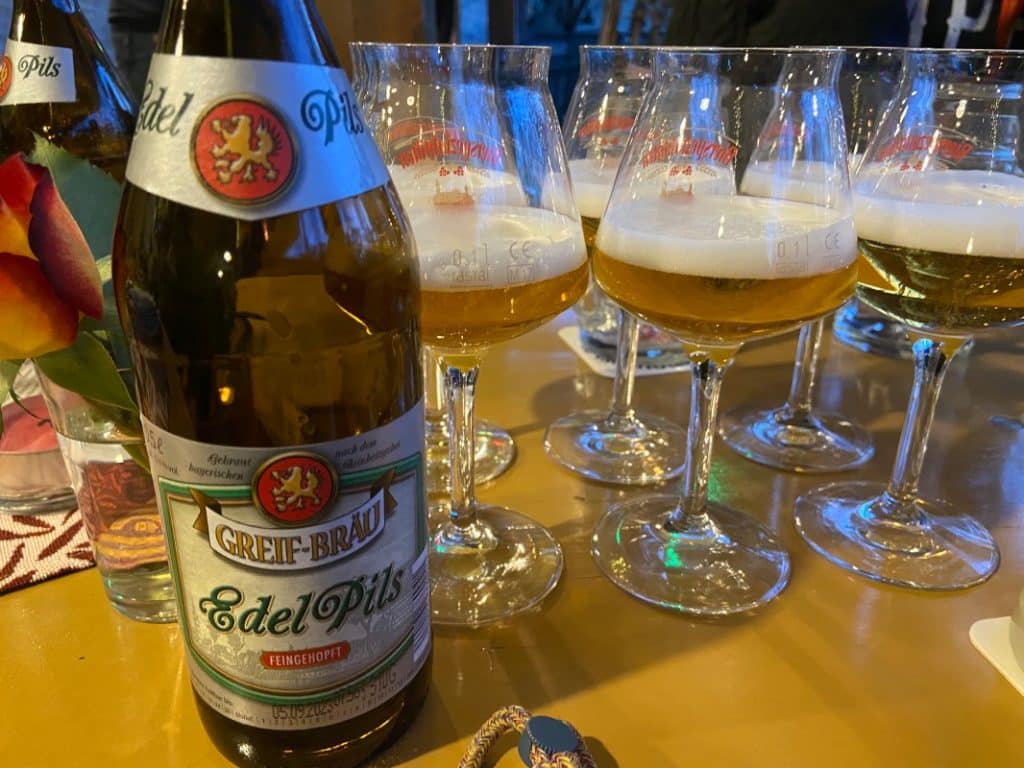
To ensure that “beer seekers” also find what they are looking for, the city has embedded stars in the ground to mark a location in the Walk of Beer. Each star is marked with a QR code that can be used to call up information about the brewery pubs.
The beauty of the Walk of Beer is that you can walk it at any time. However, if you want to stop at the Hebendanz, Neder or Greif breweries or at the Eichhorn brewery pub and cellars, you should pay close attention to the opening hours.
We tried the beer from the Neder brewery. A light tasting pale, with a wonderful porous foam. It is best to get the beer yourself at a small bar in the building. If the weather is bad, you can enjoy your beer there at bar tables or in the guest room. If the weather is nice, there are some outdoor seats.

Only a few steps away is the Hebedanz brewery. Here I drank a “Helles”. The beer tasted very drinkable with only a little bitterness. The Seidla drank away just like that.
Franconian wine
Franconia has not only beer, but also excellent wine. The wine-growing region lies between Aschaffenburg and reaches almost to Bamberg. It produces mainly white wine and Silvaner.


At a wine tasting, I was able to taste some very good wines and was surprised that, completely against my usual taste, a dry wine is my favorite.
Stadtlockal Forchheim
In the evening, we were drawn to a historic traditional restaurant in the pedestrian zone of the city center. From the outside, the lettering “Fränkische Bierstube” is still on the house, today the restaurant is called Stadtlockal.
A quaint guest room and during our visit very nice staff made every effort to manage a large group with countless individual requests. In addition to hearty Franconian specialties, we were tempted by a very special drink “Death of Forchheim”.

Properly on a board we were served various liquors:
fast death – herbal liquor with 38%.
slow death – plum liqueur with 20%
sweet death – orange liqueur with 40%

Well, what will we have drunk???? In any case, they tasted good!
We were able to visit some of the places we visited during the ReiseBlogger Barcamp with the support of Franken Tourismus and Forchheim erleben.





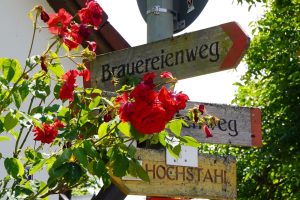




Leave a Reply